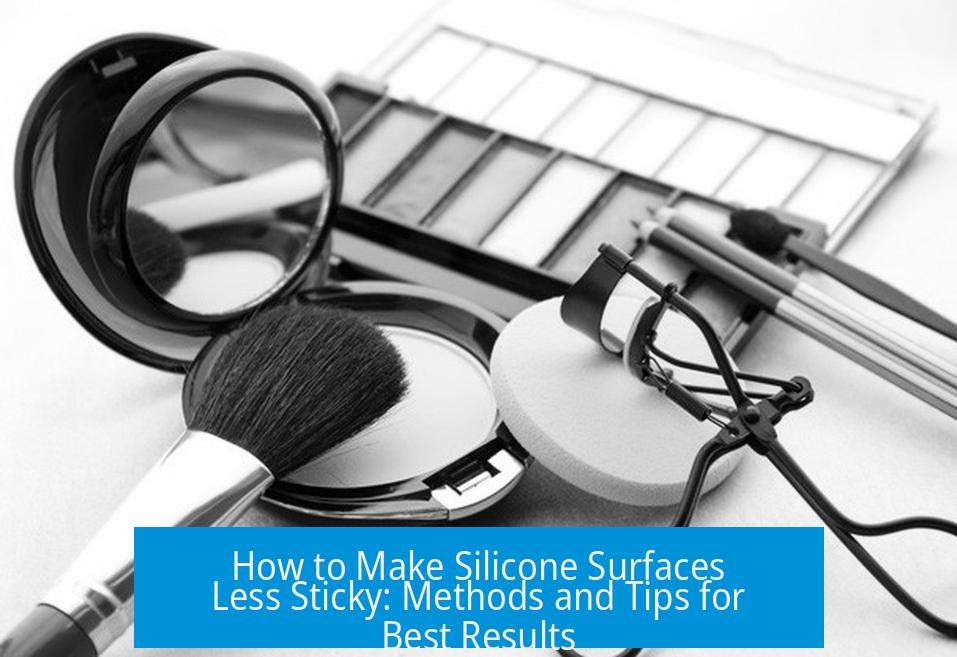How to Make Silicone Surface Less Sticky?
The stickiness of silicone surfaces results from the inherent properties of pure silicone, which is fundamentally a liquid polymer. Although fillers such as silica or iron oxide make it appear solid, a sticky liquid component remains on the surface. To reduce this stickiness, methods such as applying starch, using polyurethane spray-on sealers, or cleaning residues with baking soda are effective. Alternative informal techniques like rubbing the silicone against natural oils in hair can also help temporarily. Some common cleaning agents like alcohol or baby wipes do not remove this tackiness effectively.
Understanding Silicone Stickiness
Silicone’s sticky nature arises because pure silicone polymers are liquids at room temperature. Manufacturers add fillers—such as silica or iron oxide—to create a solid-like material. Despite these fillers, the silicone surface still has a thin liquid layer. This layer causes the surface to feel tacky or sticky. This property can attract lint, dust, and other small particles.
Sticky silicone can be inconvenient for applications requiring smooth, non-tacky surfaces. The problem spans from silicone masks and phone cases to silicone baking mats and helmets. Addressing this stickiness improves usability and longevity.
Proven Methods to Reduce Silicone Stickiness
Using Starch
Applying starch is a simple and cost-effective way to reduce stickiness. Starch acts as an absorbent powder, soaking up the oily or liquid silicone residue on the surface. This creates a dry feel instead of a tacky one. Users can dust the silicone surface with talcum or corn starch and gently rub it in.
This method is safe and preserves the flexibility of silicone. It is often preferred for items like gloves, masks, or mats.
Polyurethane Spray-On Sealers
Professionals sometimes use polyurethane spray-on sealers to eliminate silicone surface tackiness. These sealers form a thin, protective, non-sticky layer atop the silicone. The spray creates a barrier that prevents the underlying sticky layer from contacting objects or skin.
| Advantages | Disadvantages |
|---|---|
| Long-lasting reduction of stickiness | Can be expensive |
| Creates a uniform, smooth surface | May not suit all silicone uses |
| Easily available from industrial suppliers | Heat tolerance varies by polyurethane formulation |
These sprays are available from specialized suppliers such as McMaster-Carr or Grainger. Users should verify compatibility with their silicone product, especially for heat-resistant applications or food-related uses.
Cleaning Sticky Residue With Baking Soda Paste Before Sealing
Before applying polyurethane sealers, removing surface gunk improves adhesion and results. One effective cleaning method involves using a paste of baking soda and water mixed to a toothpaste-like consistency.
- Apply the paste generously on the sticky silicone, resembling the coverage of cake frosting or peanut butter.
- Let the paste dry fully without disturbance.
- Wipe off the dried paste carefully. If time is limited, scrub gently with a toothbrush to remove residues.
- Wash the silicone surface with a mild detergent like Dawn dish soap. This removes residual baking soda particles.
- Pat the surface dry with a towel and allow air drying thoroughly, preferably in front of a fan for at least 24 hours, depending on object size.
This cleaning routine eliminates oils, dust, and sticky contaminants. Thorough drying ensures complete water removal before sealing.
Alternative Informal Technique: Hair Rub
One unconventional method documented involves using natural hair oils. The process includes avoiding washing hair for a month, then rubbing a sticky silicone surface, such as a phone case, on the hair. This transfers oils and smooths the silicone surface, reducing tackiness temporarily.
This method capitalizes on the lubricating properties of natural scalp oils. However, it is less practical for large surfaces or situations needing hygiene and durability.
Ineffective Methods and Common Misconceptions
Common cleaning agents such as commercial baby wipes or alcohol are often used against silicone stickiness. In practice, these substances neither remove the tacky surface effectively nor prevent lint accumulation.
For example, collectors of silicone masks report that using alcohol wipes or baby wipes fails to reduce stickiness or remove the accumulation of lint and hair particles. These agents might clean surface dirt but do not address the sticky liquid layer intrinsic to silicone.
Summary of Practical Steps to Reduce Silicone Stickiness
- Identify the cause: Silicone’s inherent liquid polymer nature causes surface stickiness, even with fillers.
- Starch application: Dusting with starch powders can absorb surface stickiness and dry the material.
- Cleaning with baking soda paste: Remove surface residues using a baking soda and water paste, then rinse and dry thoroughly.
- Seal with polyurethane spray: Apply a compatible polyurethane sealer to form a barrier reducing tackiness and improving durability.
- Avoid ineffective cleaners: Baby wipes, alcohol, and similar agents may not change the sticky surface and can cause uneven texture.
- Use informal methods carefully: Natural oils from hair can temporarily reduce tackiness but are not practical for all uses.
Additional Considerations
Not all methods suit every silicone product. For example, silicone kitchenware demands food-safe treatments that heat can influence. Therefore, users must verify heat tolerance and safety when applying sealers.
Professional-grade polyurethane sealers may react differently depending on their formulation. Testing on a small area before full application avoids potential damage or discoloration.
Conclusion: Making Silicone Surfaces Less Sticky
Reducing silicone stickiness entails understanding its chemical and physical properties. Using starch or baking soda effectively manages tackiness by absorbing surface liquid. Polyurethane spray sealers provide a long-term fix by sealing the stickiness within a tough layer. Informal techniques like hair rubbing rely on natural oils for a quick surface polish but lack permanence or practicality.
- Silicone’s stickiness results from its liquid polymer nature despite fillers.
- Starch and baking soda-based cleaning reduce stickiness effectively.
- Polyurethane sprays create a lasting, non-sticky surface but vary in suitability.
- Common cleaners like alcohol and baby wipes do not remove silicone tackiness.
- Alternative natural oils methods offer temporary improvements only.
Why is silicone surface sticky even when it feels solid?
Silicone is naturally a liquid. Fillers like silica or iron oxide turn it solid, but the sticky liquid remains beneath the surface, causing the tackiness.
Can starch reduce the stickiness of silicone?
Yes, applying starch can reduce silicone’s stickiness. It acts as a simple and effective way to make the surface less tacky.
How does polyurethane spray help with sticky silicone surfaces?
Polyurethane spray-on sealers can remove stickiness from silicone rubber surfaces by creating a barrier. However, they can be expensive and may not suit all uses, especially with heat-sensitive items.
What is the best way to clean sticky residue before applying polyurethane?
Mix baking soda with water to make a paste. Spread it thickly on silicone and let it dry, then wipe off. Clean leftover baking soda with dish soap, then dry the item fully before spraying.
Does rubbing silicone on hair really reduce stickiness?
Yes. If you don’t wash your hair for a month, rubbing the silicone on your hair makes it shinier and smoother, reducing its sticky feel somewhat.





Leave a Comment